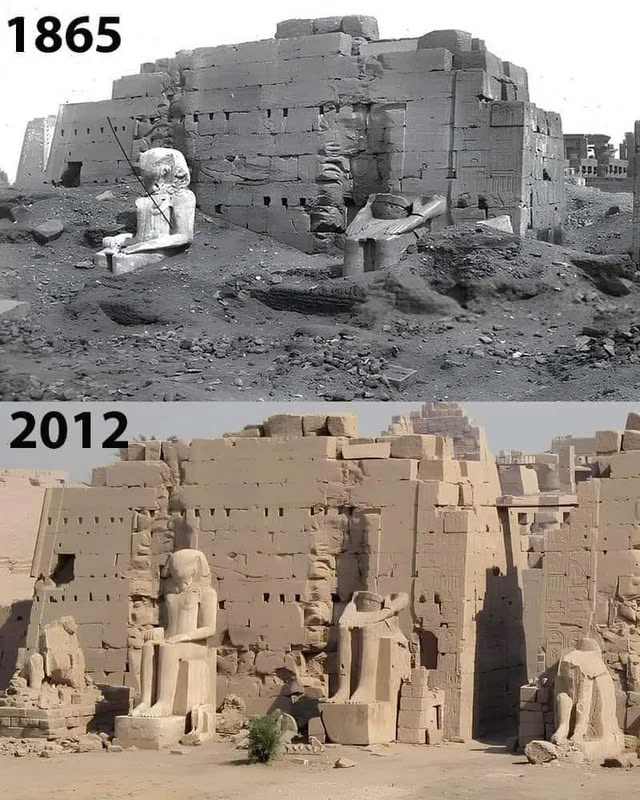In the sweltering heat of Egypt in 1865, a French Egyptologist named Auguste Mariette embarked on an ambitious mission that would cement his legacy as one of the most pivotal figures in the preservation of ancient Egyptian heritage. His task was monumental: to breathe new life into the decaying ruins of Karnak Temple, a sprawling complex that once stood as a beacon of ancient Egyptian civilization. Over the centuries, the temple had fallen into disrepair due to relentless natural erosion, opportunistic looters, and sheer neglect, its grandeur nearly forgotten. Yet, Mariette was undeterred, driven by a passion for uncovering the past and preserving it for future generations.
Unveiling Hidden Wonders
With the precision of a surgeon and the passion of an artist, Mariette approached the restoration of Karnak Temple as both a scientific and an artistic endeavor. His years of fieldwork had left his hands calloused, yet steady and skilled. Carefully, he swept away layers of accumulated debris, revealing the magnificence that lay buried beneath. Bit by bit, long-concealed structures began to emerge from the sands of time, each discovery more breathtaking than the last.

The challenges Mariette faced were immense. Stabilizing weakened walls and towering pillars required not only technical expertise but also an unwavering commitment to preserving the original integrity of the temple. He meticulously reinforced crumbling structures, ensuring that their authenticity was never compromised. His efforts culminated in the restoration of the hypostyle hall, a colossal space filled with rows of towering columns that seemed to reach toward the heavens. Nearby, ancient obelisks—once toppled or buried—were raised again to stand proudly, their intricate hieroglyphs recounting the stories of pharaohs who had long since faded into history.
Reigniting Global Fascination
Mariette’s work extended beyond the physical restoration of Karnak Temple; it rekindled the world’s fascination with ancient Egypt. As news of his progress spread, scholars, adventurers, and curious onlookers flocked to Karnak, eager to witness the revival of this historic site. The temple’s renewed splendor captured imaginations worldwide, sparking a surge of interest in ancient Egyptian culture and history.
This growing fascination laid the foundation for future archaeological endeavors throughout Egypt. Mariette’s work inspired a wave of exploration and preservation, as both professionals and enthusiasts sought to uncover more of the secrets hidden in Egypt’s sands. The preservation of Karnak Temple became a turning point in the broader field of Egyptology, ushering in a new era of systematic excavation and conservation.
The Birth of Modern Egyptology
Even before his work at Karnak, Mariette had demonstrated a deep commitment to safeguarding Egypt’s treasures. In 1858, he established the Egyptian Antiquities Service, an organization dedicated to the systematic excavation, documentation, and preservation of Egypt’s archaeological sites. This institution, which later evolved into a cornerstone of modern Egyptology, set new standards for the field and ensured that Egypt’s cultural heritage would be protected for generations to come.
Mariette’s vision extended beyond the immediate restoration of Karnak. He recognized the need for a comprehensive approach to preservation, one that balanced scientific rigor with a deep respect for the past. His foresight in creating the Egyptian Antiquities Service provided the framework for countless future discoveries, ensuring that Egypt’s ancient wonders would be studied and appreciated rather than exploited.
A Legacy Carved in Stone
Today, Karnak Temple stands as one of the most renowned archaeological sites in the world, a testament to Mariette’s dedication and vision. Visitors from across the globe marvel at its timeless beauty, walking among the columns of the hypostyle hall and gazing up at the obelisks that once again reach skyward. These preserved structures offer a window into the achievements of an ancient civilization, their hieroglyphs whispering stories of a time long past.
Mariette’s work did more than preserve stone and mortar; it safeguarded a priceless legacy. By rescuing Karnak Temple from the brink of oblivion, he ensured that future generations would continue to learn from and be inspired by the ingenuity of the ancient Egyptians. His contributions to the field of Egyptology remain unparalleled, influencing not only the study of ancient Egypt but also the broader principles of archaeological preservation.
A Timeless Reminder
The story of Auguste Mariette and his work at Karnak Temple serves as a powerful reminder of the transformative impact one individual can have. Through his unwavering dedication and meticulous efforts, Mariette changed the course of history, saving a cultural treasure that might otherwise have been lost forever. His legacy endures in the awe-struck faces of visitors who explore Karnak today, marveling at its grandeur and the stories it holds.
Mariette’s achievements highlight the importance of preservation in connecting humanity with its shared past. The restoration of Karnak Temple is more than just a historical accomplishment; it is a testament to the enduring power of passion and vision. Every carefully preserved hieroglyph, every meticulously stabilized column, and every raised obelisk reflects Mariette’s commitment to protecting the past for the enrichment of future generations.
Conclusion: Preserving the Past for the Future
Auguste Mariette’s work at Karnak Temple stands as a beacon of what is possible when passion and purpose align. By restoring this ancient wonder, Mariette not only ensured its survival but also reignited a global fascination with ancient Egypt. His efforts continue to inspire archaeologists, historians, and everyday visitors, reminding us of the enduring value of cultural heritage.
As we walk among the ruins of Karnak Temple today, we are not merely observing stone and architecture; we are connecting with a legacy that transcends time. Mariette’s story is one of resilience, vision, and the profound impact that one person can have in preserving the treasures of the past. It is a legacy that invites us all to reflect on the importance of safeguarding history, ensuring that its lessons and beauty endure for generations to come.





